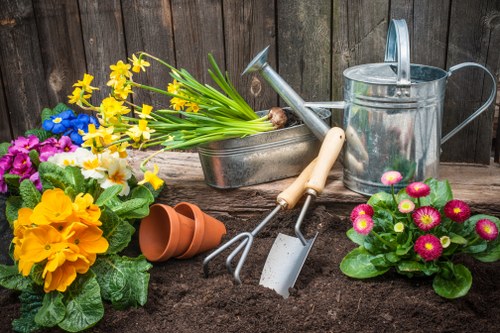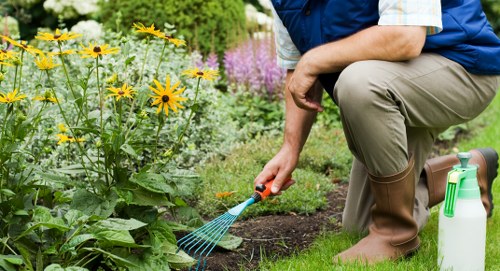Driveway Algae Removal in Harold Wood: Effective Solutions for a Clean Path

Maintaining a clean and safe driveway is essential for any homeowner. However, one common issue that can detract from the appearance and safety of your driveway is algae growth. In Harold Wood, where the damp climate can create the perfect environment for algae to thrive, addressing this problem promptly is crucial.
Algae not only makes your driveway look unsightly but can also create slippery surfaces, posing a risk to both pedestrians and vehicles. This article explores effective methods for driveway algae removal in Harold Wood, offering both DIY solutions and professional services to help you maintain a pristine driveway.
Understanding the causes and impacts of algae growth is the first step towards effective removal. We'll also delve into preventive measures to ensure your driveway remains algae-free year-round.

Understanding Algae Growth on Driveways
Algae are simple, plant-like organisms that thrive in moist, shaded environments. They can grow on various surfaces, including concrete, asphalt, and paving stones, which are common materials for driveways.
What Causes Algae to Grow on Driveways
The primary factors contributing to algae growth on driveways include:
- Moisture: Algae require moisture to grow. Driveways that retain water due to poor drainage or frequent rainfall are particularly susceptible.
- Shade: Areas with limited sunlight provide ideal conditions for algae to flourish.
- Organic Material: Dirt, leaves, and other organic debris can provide nutrients that support algae growth.
The Impact of Algae on Your Property
Algae growth can have several adverse effects on your property:
- Slippery Surfaces: Algae can make your driveway slippery, increasing the risk of accidents.
- Aesthetic Decline: Algae can make your driveway look neglected and can lower the overall appearance of your property.
- Structural Damage: Over time, algae can contribute to the deterioration of driveway materials, leading to cracks and other structural issues.

Effective Methods for Removing Algae from Driveways
There are several methods available for removing algae from driveways, ranging from simple DIY solutions to professional services. The best approach depends on the severity of the algae growth and your personal preferences.
DIY Solutions for Algae Removal
If you prefer to tackle the problem yourself, there are several effective DIY methods:
Using Bleach and Water Solutions
Bleach is a powerful agent for killing algae. To create a bleach solution:
- Mix one part bleach with three parts water.
- Apply the solution to the affected areas using a brush or sprayer.
- Allow it to sit for 15-20 minutes.
- Scrub the area to remove the algae.
- Rinse thoroughly with water.
**Note:** Be cautious when using bleach, as it can damage plants and surrounding vegetation.
Vinegar-Based Cleaners
For a more environmentally friendly option, vinegar can be used:
- Use undiluted white vinegar.
- Apply directly to the algae-covered areas.
- Let it sit for about 30 minutes.
- Scrub the surface to remove the algae.
- Rinse with water.
Vinegar is less harmful to plants but may require more effort to remove heavy algae growth.

Professional Algae Removal Services
If the algae problem is extensive or you prefer a hands-off approach, hiring professionals is the best option. Professional services in Harold Wood offer:
- Advanced Cleaning Techniques: Using specialized equipment and cleaning agents for effective removal.
- Safety Assurance: Minimizing risks associated with DIY methods, such as chemical exposure.
- Preventative Measures: Implementing solutions to hinder future algae growth.
Choosing the Right Algae Removal Service in Harold Wood
Selecting a reputable algae removal service is essential for ensuring effective and lasting results. Here are some factors to consider:
Factors to Consider
- Experience: Look for companies with a proven track record in driveway algae removal.
- Reviews and Testimonials: Check customer feedback to gauge service quality.
- Cost: Obtain quotes from multiple providers to find a service that fits your budget.
- Eco-Friendly Options: If environmental impact is a concern, choose services that use green cleaning solutions.
Top-rated Local Services
In Harold Wood, several companies stand out for their exceptional algae removal services:
- Harold Wood Cleaners: Known for their thorough cleaning and customer satisfaction.
- Green Driveway Solutions: Offers eco-friendly algae removal options.
- QuickClean Driveways: Provides fast and efficient services at competitive prices.
Preventing Algae Growth on Driveways
Prevention is always better than cure. Implementing regular maintenance can significantly reduce the likelihood of algae regrowth.
Regular Maintenance Tips
- Keep Driveways Dry: Ensure proper drainage to prevent water accumulation.
- Remove Organic Debris: Regularly clean leaves and dirt from your driveway.
- Sunlight Exposure: Trim surrounding vegetation to increase sunlight exposure.
Sealing Your Driveway
Applying a sealant to your driveway can create a protective barrier against moisture and algae growth. Sealants also enhance the appearance and longevity of driveway surfaces.

Nearby Areas in Harold Wood for Driveway Algae Removal
For residents of Harold Wood seeking driveway algae removal, services are available in the surrounding areas as well. Here are some of the closest areas:
- Elm Park: Just a short drive from Harold Wood, Elm Park offers residents access to top-notch algae removal services.
- Hornchurch: Known for its vibrant community, Hornchurch has several reliable cleaning service providers.
- Upminster: Upminster's local services are highly rated for their effectiveness and professionalism.
- Romford: A larger area with numerous service options to tackle driveway algae problems.
- Emerson Park: Emerson Park offers specialized services catering to residential driveway maintenance.
- Goodmayes: With a variety of cleaning companies, Goodmayes is a convenient option for nearby residents.
- Collier Row: Collier Row provides accessible services with tailored solutions for algae removal.
- Purfleet: Known for its community-focused services, Purfleet residents can find effective driveway cleaning options.
- Montfichet: Montfichet offers both DIY supplies and professional services for algae management.
- Rainham: Rainham's local businesses excel in driveway maintenance and algae removal.
- Chadwell Heath: Chadwell Heath provides robust services to ensure clean and safe driveways.
- Brentwood: With extensive experience, Brentwood's companies are adept at handling stubborn algae issues.
- Basildon: Basildon offers a wide range of services, from DIY supplies to full-service cleaning.
- Tilbury: Tilbury's proximity to Harold Wood makes it a convenient choice for algae removal services.
- Chapelfields: Chapelfields boasts reliable and efficient driveway cleaning professionals.

Frequently Asked Questions
1. How often should I clean my driveway to prevent algae growth?
Regular cleaning every few months, especially during damp seasons, can significantly reduce the likelihood of algae growth. Additionally, implementing preventive measures like sealing your driveway can further deter algae development.
2. Are there eco-friendly methods for removing algae from driveways?
Yes, vinegar-based cleaners and hydrogen peroxide solutions are effective and environmentally friendly alternatives to harsh chemicals like bleach.
3. Can algae damage my driveway?
While algae primarily affects the appearance of your driveway, prolonged growth can contribute to surface deterioration, leading to cracks and other structural issues over time.
4. Is it better to hire a professional for algae removal?
Hiring a professional ensures thorough and safe removal, especially for extensive algae growth. Professionals also offer preventative solutions to minimize future occurrences.
5. How can I prevent algae from growing back after cleaning?
Preventive measures include ensuring proper drainage, keeping your driveway dry, removing organic debris regularly, increasing sunlight exposure by trimming surrounding vegetation, and applying a sealant to create a protective barrier against moisture.


